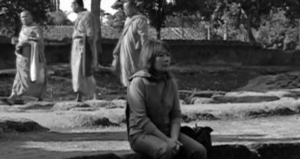GOOD FILM WORKS
DVD, 57 MINUTES, 2006
Reviewed by Nancy Janus

Out of the Poison Tree, written, directed, and produced by Beth Pielert, details the return to Cambodia of three sisters in search of information on the death of their father at the hand of the Khmer Rouge regime in 1979. This magnificently photographed film introduces the viewer as much to life in modern-day Cambodia as it does to the horrible history of the 1970s genocide.
The film begins with the three sisters at home in California planning their trip to Cambodia and includes the viewer with them as they travel from urban Phnom Penh, to their father’s rural village where he was last seen, to Angkor Wat’s beautiful temples. The sisters interview survivors who still feel the pain of their losses and others who believe that Cambodians simply need to forget and get over being angry. We meet Cambodian people like a former Khmer Rouge soldier who is filled with regret for what he did, explaining that he was trapped by the political situation and fear, and a landmine detonator who has created a museum of his finds. A novice monk teaches us his Buddhist perspective on genocide—that even if a person does not have bad karma from a former life, he or she should forgive and forget in this one so that the war does not go on.
The film is complicated, following the sisters on their quest and simultaneously teaching a history lesson to those unfamiliar with the Khmer Rouge period in Cambodia. For a person well versed in Cambodian history it is not difficult to follow, but the history lesson is not linear and can be confusing. For example, we see horrifying video of the American planes carpet-bombing the eastern sections of Cambodia while Richard Nixon and Henry Kissinger assert that peace is at hand. These images are juxtaposed with historical footage of Phnom Penh devoid of inhabitants, but there is no explanation as to why or any orientation about the Khmer Rouge ideology. For classroom use, students will need some background information on Cambodian history before showing the film.
The viewer does not really get to know the three sisters in this film very well, but the Cambodians who are interviewed are amazing studies in character. Each one is allowed to tell his or her story in full with what appears to be very little editorial cutting. A perfect example is the village widow sharing the story of her husband’s disappearance. The pain the woman feels as she tells how she watches every car drive by, hoping against hope for his return to her, is agonizing. In a later scene, a high school girl of sixteen dissolves into tears as she tells why it is important to have the Khmer Rouge Tribunals in order to avenge the deaths of her own relatives whom she never knew. As a people, Cambodians tend to keep a stiff upper lip and try to put painful memories out of their minds. These interviews open the window for their stories to pour out, and they are very real and moving for the viewer.
Out of the Poison Tree has the political agenda of communicating how important the Tribunals are to purging the Cambodian people of their thirty years of pain. The film dates itself as it tells us repeatedly that the trials will soon begin, and that only Comrade Duch, the director of the Toul Sleng S-21 torture prison, will be tried. As of this writing, in September 2009, the trials have gone on since March, and after six months on the stand, the testimony of Comrade Duch just ended. The remaining perpetrators, reported in the film as having made deals with Prime Minister Hun Sen in order not to stand trial, await trial in prison with Comrade Duch.
The utility of this film depends on its purpose in the classroom. As a record of contemporary Cambodia and the ways that the Khmer Rouge experience continues to affect the people thirty years later, it is excellent. As a vehicle to teach about the genocide, the Hollywood production The Killing Fields may be more useful. A third choice for teaching the history, although it is very difficult to watch, is the French film, S21:The Khmer Rouge Killing Machine. This movie provides a detailed window into exactly how the Khmer Rouge dealt with its victims and reveals the lasting pain that many members of the former Khmer Rouge army feel today as they look back over their crimes.
Finally, Out of the Poison Tree offers a set of brief video clips on the menu screen called “Gems from the Cutting Room Floor.” The clips are photographically lovely but very short and probably of limited utility to the teacher. The menu also offers a study guide in pdf format. Unfortunately, even with the included instruction this reviewer was unable to open it, although it is available online at http://distribution.asianamericanmedia.org/wp-content/uploads/pdfs/study_guides/OutPoisonTree_studyguide.pdf.
Editor’s Note: A link to the study guide will be posted on the EAA Web site.

